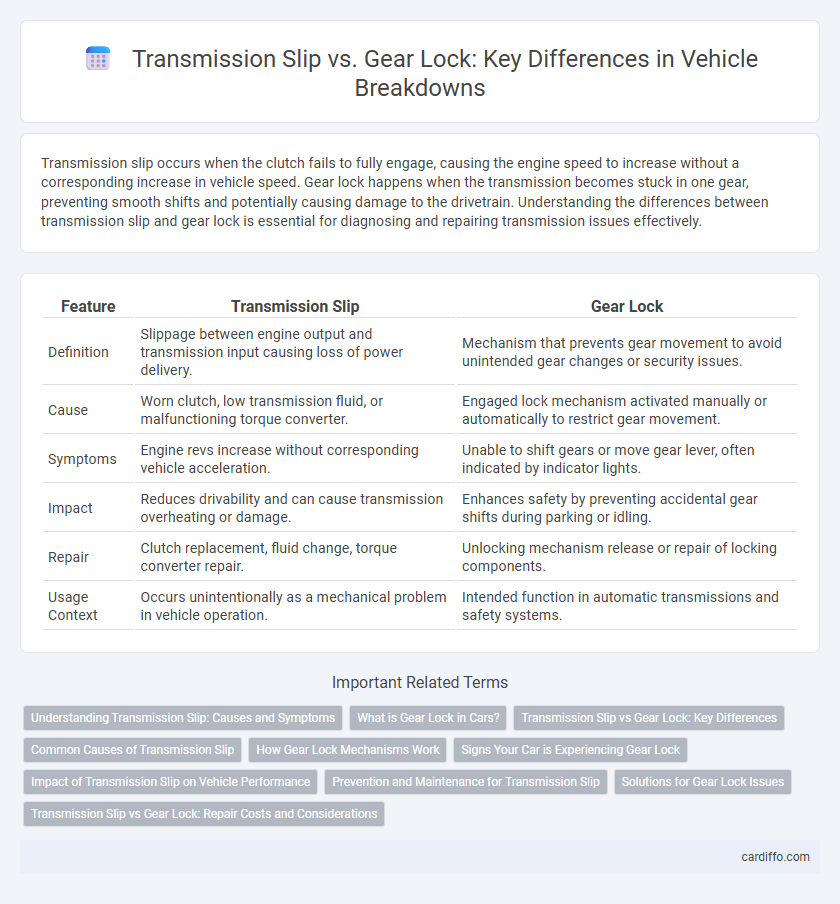Transmission slip occurs when the clutch fails to fully engage, causing the engine speed to increase without a corresponding increase in vehicle speed. Gear lock happens when the transmission becomes stuck in one gear, preventing smooth shifts and potentially causing damage to the drivetrain. Understanding the differences between transmission slip and gear lock is essential for diagnosing and repairing transmission issues effectively.
Table of Comparison
| Feature | Transmission Slip | Gear Lock |
|---|---|---|
| Definition | Slippage between engine output and transmission input causing loss of power delivery. | Mechanism that prevents gear movement to avoid unintended gear changes or security issues. |
| Cause | Worn clutch, low transmission fluid, or malfunctioning torque converter. | Engaged lock mechanism activated manually or automatically to restrict gear movement. |
| Symptoms | Engine revs increase without corresponding vehicle acceleration. | Unable to shift gears or move gear lever, often indicated by indicator lights. |
| Impact | Reduces drivability and can cause transmission overheating or damage. | Enhances safety by preventing accidental gear shifts during parking or idling. |
| Repair | Clutch replacement, fluid change, torque converter repair. | Unlocking mechanism release or repair of locking components. |
| Usage Context | Occurs unintentionally as a mechanical problem in vehicle operation. | Intended function in automatic transmissions and safety systems. |
Understanding Transmission Slip: Causes and Symptoms
Transmission slip occurs when the transmission fails to transfer power effectively from the engine to the wheels, often caused by worn clutch plates, low transmission fluid, or damaged gears. Symptoms of transmission slip include delayed acceleration, a burning smell, engine revving without corresponding speed increase, and erratic shifting patterns. Differentiating transmission slip from gear lock involves recognizing that slip presents as loss of power and smoothness, while gear lock manifests as a sudden inability to change or engage gears.
What is Gear Lock in Cars?
Gear lock in cars refers to a condition where the transmission gear becomes immobilized, preventing the driver from shifting gears smoothly or at all. This issue often results from mechanical failures such as worn synchronizers, damaged shift forks, or debris obstructing gear engagement. Unlike transmission slip, which causes gears to disengage unexpectedly, gear lock physically restricts gear movement, potentially leading to hazardous driving situations.
Transmission Slip vs Gear Lock: Key Differences
Transmission slip occurs when the clutch or torque converter fails to maintain proper connection, causing a loss of power transfer between the engine and transmission, resulting in delayed or irregular acceleration. Gear lock happens when the transmission gears fail to disengage or shift smoothly, leading to the vehicle being stuck in a specific gear and preventing normal gear changes. Understanding the key differences between transmission slip and gear lock is crucial for diagnosing issues related to power delivery and gear shifting malfunctions in vehicles.
Common Causes of Transmission Slip
Transmission slip commonly results from worn clutch plates, insufficient transmission fluid, or damaged torque converters, causing inefficient power transfer and delayed acceleration. Gear lock, often caused by faulty synchronizers or damaged shift forks, differs by preventing gear engagement rather than slippage. Addressing transmission fluid quality and ensuring regular maintenance can help prevent these issues and maintain smooth vehicle operation.
How Gear Lock Mechanisms Work
Gear lock mechanisms work by physically preventing the movement of gears to maintain the desired transmission position under load, ensuring stability during operation. These systems often employ pawls, detents, or locking pins that engage teeth or notches on gears or shafts to resist slipping or unintended shifts. Unlike transmission slip, which involves insufficient friction or torque transfer causing slippage between components, gear locks provide mechanical interlock, enhancing control and preventing drivetrain malfunctions.
Signs Your Car is Experiencing Gear Lock
Signs your car is experiencing gear lock include sudden inability to shift gears, grinding noises when attempting to change gears, and the vehicle unexpectedly stalling during acceleration. Transmission slip differs, as it typically presents with delayed acceleration or the engine revving without corresponding speed increase. Persistent gear lock symptoms require immediate diagnosis to prevent further drivetrain damage.
Impact of Transmission Slip on Vehicle Performance
Transmission slip causes delayed power delivery and reduced acceleration, significantly impairing vehicle responsiveness. This slippage leads to increased heat and wear within the transmission system, accelerating component failure and costly repairs. Persistent transmission slip negatively affects fuel efficiency and overall drivability, diminishing the vehicle's operational reliability.
Prevention and Maintenance for Transmission Slip
Transmission slip occurs when the clutch or bands fail to engage properly, causing delayed or erratic power transfer. Regularly checking and adjusting the transmission fluid level and quality, along with timely replacement, helps prevent slip by ensuring proper hydraulic pressure. Routine inspection of the clutch plates and bands for wear and prompt replacement maintains optimal transmission performance and prevents gear slippage.
Solutions for Gear Lock Issues
To resolve gear lock issues in transmissions, first inspect and replace worn or damaged shift cables and linkage components to ensure smooth gear engagement. Regularly check transmission fluid levels and quality, as low or contaminated fluid can cause internal gear locking. Implementing timely maintenance, including clutch adjustments and synchronization checks, prevents gear lock and extends transmission lifespan.
Transmission Slip vs Gear Lock: Repair Costs and Considerations
Transmission slip often indicates worn clutch plates or low fluid levels, leading to gradual performance degradation, with repair costs typically ranging from $1,500 to $3,500 depending on vehicle make and transmission type. Gear lock, caused by damaged synchronizers or shift forks, results in immediate inability to change gears and generally requires more extensive gearbox repairs or replacement, with expenses soaring up to $4,000 or more. Considering durability, maintenance history, and specific symptoms helps determine whether a partial repair or full transmission rebuild is the most cost-effective solution.
Transmission slip vs gear lock Infographic

 cardiffo.com
cardiffo.com